THE WHITE TIGER - A LOOK AT THE HISTORY OF ANIMALS WITHOUT COLOR - PART I
The white tigers are examples of tiger (Panthera tigris) with a genetic condition that almost eliminates the pigment of its normally orange coloration, although the black stripes are not affected. This occurs when a tiger inherits two copies of the recessive gene for pale coloration: pink nose, ice-blue eyes, and cream-white skin with black, gray, or light brown stripes.
White tigers are not a separate subspecies and are fertile with orange tigers, although all the resulting offspring will be heterozygous for the recessive gene, and their coloration will be orange. The only exception would be if the orange progenitor was also a heterozygous tiger with a recessive gene for pale coloration, which would give it a 50% chance of being double recessive for white or heterozygous for orange.
The white tigers are usually of the subspecies of the Bengal tiger (Panthera tigris tigris) or the Siberian tiger (Panthera tigris altaica), although there are historical data of appearance in several more subspecies. Currently, several hundred white tigers are in captivity around the world, with 100 of them in India, and their number is increasing. The current population includes pure Bengal tigers and Bengal and Siberian hybrids, but it is uncertain whether the white recessive gene came only from Bengal or Siberian.
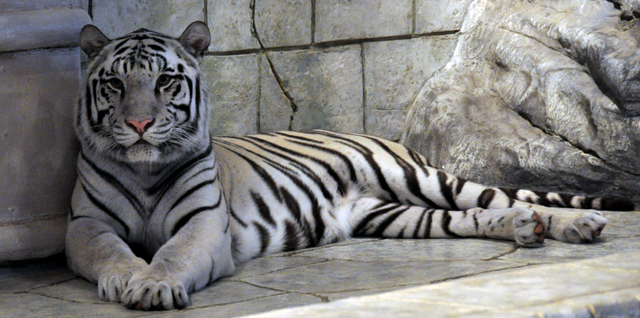
Image source :https://upload.wikimedia.org
The unusual coloration of white tigers has made them popular in zoos and in exotic animal shows. The wizards Siegfried and Roy are famous for having raised and trained white tigers for their numbers, referring to them as "white royal tigers," perhaps because of the association of the white tiger with the maharas of Rewa (India).
It is a myth that white tigers do not thrive in the wild, where small groups have been raised white for generations.
A. A. Dunbar Brander wrote in Wild Animals in Central India (from 1923):
White tigers appear occasionally. There are regular breeding of these animals in the vicinity of Amarkantak, in the junction of the state of Rewa and the districts of Mandla and Bilaspur. When I was last in Mandla in 1919, there was a tigress and two or three puppies. In 1915 a male was captured in the state of Rewa and was kept in confinement. An excellent description of this animal by Mr. Scott of the Indian police was published in vol. 27, no. 47, from the Journal of Natural History of the Bombay Society.
A. Dunbar Brander
CHARACTERISTICS OF THE WHITE TIGER
White tigers are the largest living felines. As previously stated, they have pink nose, ice blue eyes and white skin with black, gray or chocolate stripes. Some develop a genetic condition that produces pale streaks, so they look totally white. This guy is known as snow white.
The average length of your body, including the head, is approximately 3 meters. The tail has a length of 75 to 91 cm. It weighs about 290 kg. Compared to orange tigers, whites are larger, even from birth. In the adult stage, the difference is even more noticeable.
White tigers are sired by Bengal tigers and in rare cases, the mutation may originate from Siberian tigers.
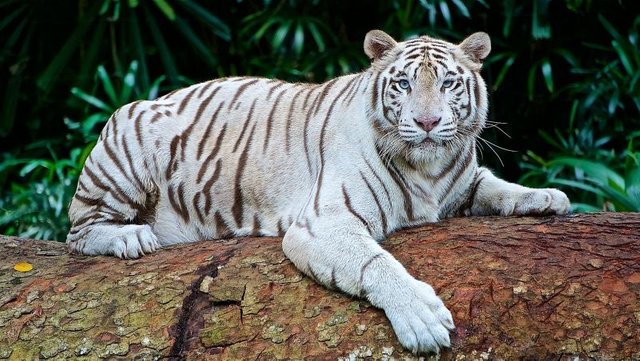
Image source :https://upload.wikimedia.org
The white tiger is descended from tigers that carry an unusual gene, responsible for the tone of the skin. It has a genetic characteristic that eliminates the orange pigment, but maintains the distinctive black stripes of its species.
This phenomenon happens when the tiger receives two copies of the recessive gene. This is due to his blue eyes, pink nose and white or cream skin. Wild white tigers are unique species.
HABITAT DEL TIGRE BLANCO
The white tiger inhabits areas where the vegetation is shrubby, populated by bushes and scattered trees. You can walk through the real jungles and jungles, but opt for the wooded areas with clear spaces, to be able to cope more easily. It is one of the few cats that has managed to survive to this day.
Commonly it is located in the continental part of Southeast Asia and in the central and southern zone of India. Many of them are found in zoos and parks with special fauna.
This animal is a magnificent swimmer, but a very bad climber. It can run, but it does it slowly. He is cautious and agile enough to hold on to any prey that gets in his way.

Image source :https://upload.wikimedia.org
FEEDING OF THE WHITE TIGER
The white tiger is a carnivorous animal, and its feeding is very varied. It eats large mammals such as deer, pigs, cows and wild boar, but as there is a shortage of these species, it feeds on everything that it can hunt or that approaches it, be they frogs, insects, lizards, monkeys, young elephants, birds, fish. , other felids, canids and bears.
The white tiger lurks alone. Both the female and the male are hunters par excellence. The white tigers of Bengal stand alone in an extensive territory or area of action. However, sometimes they travel in small groups.
Most undertake their persecutions during the night. Stealth, surprise and darkness allow them to blend in with vegetation to successfully capture their victims.
REPRODUCTION OF THE WHITE TIGER
There is no specific season for the reproduction of tigers. They can do it throughout the year, although most of the time it happens between November and the beginning of April. The males begin to mate from 5 years of age and females approximately 3 and a half years.
When they come into contact they sniff each other, they purr, rubbing against each other. This is very common in them. The pregnancy lasts about 16 weeks. The females look for a lair before giving birth. At the moment, they give birth to three young, weighing 1 to 3 kg each. At birth they are dependent on the mother, because they can not see. They open their eyes after 14 days, but despite that they continue to be breastfed for 30 more days.
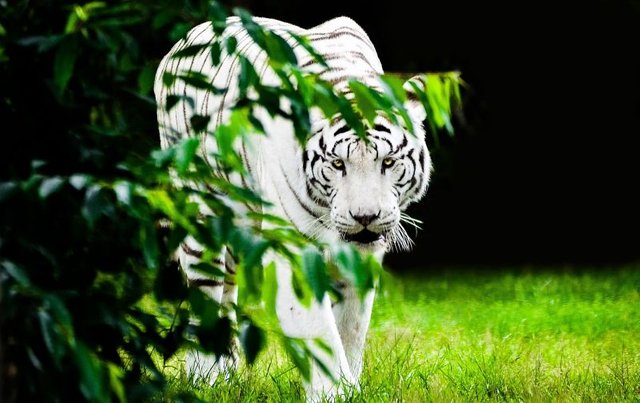
Image source:https://upload.wikimedia.org
The puppies are born white and remain in the cave for about 8 weeks. The mother really cares for them alone, she gets them food and protects them. The males, on the other hand, try to kill them when they run into them trying to get the female to mate again.
It should be noted that the white tiger is not an isolated subspecies. In addition, it can be fertilized with orange tigers. From this union will be born with orange fur and heterozygotes, due to the recessive gene.
In case the other orange parent was also a heterozygous tiger with recessive genes for pale coloration, there is a 50% chance that the pups are doubly recessive for white or heterozygous for orange.
The majesty of the white tiger and its unusual coloration has made them very popular. They are very attractive specimens in zoos and exotic animal shows. It is a species in danger of extinction, leaving very few worldwide. Many of them are in captivity. Only thus is their survival guaranteed for a longer time.
THE DANGERS THAT THREATEN THE WHITE TIGER
Although the white tiger itself is not included inside
of the red list of critically endangered animals, in fact it is indirectly because it is a mutation of the Bengal tiger, which is included.
That is to say, there are very few specimens but since it is not a single species or subspecies but the result of a genetic modification, it can not be contemplated directly, since by managing to save the bengal tiger it would also be possible to save the white tiger.
It is therefore important to take into account the importance of the dangers that threaten the Bengal tiger, which range from poaching for the sale of bones and skins to the loss and division of its habitat, which makes it difficult to find places where it can reproduce and develop properly, also seeing the amount of prey that is within reach.
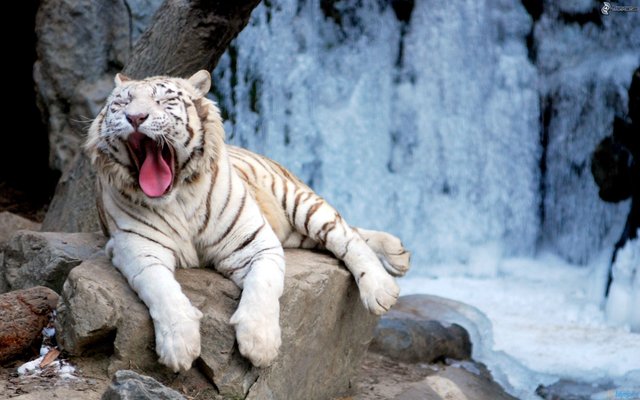
Image source :https://upload.wikimedia.org
Their eyes are generally blue, but they can be green or amber. There are several hundred tigers of this subspecies in captivity throughout the world, a number that increases annually. There is an interesting story about the discovery of the first white Bengal. In India, in one of the royalties led by Maharaja Shri Martand Singh of Rewa, they had killed a white tigress. Later, they found four puppies of her, those who were shot, except the white puppy.
The Maharaja of Rewa offered his guest, the also Mahajá Ajit Singh of Jodhpur, the honor of shooting the white puppy, but he refused.
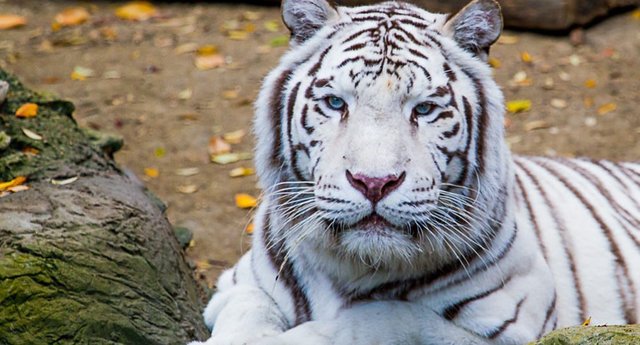
Image source :https://upload.wikimedia.org
Endogamy and conservation
Due to the small size of the gene pool, many white Bengal tigers suffer from health problems due to inbreeding. For this reason, responsible zoos refuse to raise two white Bengal tigers together.
However, two white parents are the only way to guarantee obtaining white puppies. If a Bengal white has a partner that is heterozygous for the gene, only half of the offspring will be white.
Therefore, due to the high demand of white Bengal tigers, less scrupulous breeders still breed white tigers together. Some animal rights activists have called for an end to the breeding of Bengal white tigers completely.
Outside India, highly inbred Bengal white tigers are prone to crossed eyes (strabismus) due to improperly routed visual pathways in the brain, problems of astronomy and postures, a weakened immune system and poor tolerance to anesthesia, possibly due to the inability to synthesize the tyrosinase enzyme.

Image source :https://upload.wikimedia.org
Behavior and diet
The white tigers of Bengal lead solitary lives and the period of courtship, and the association between mother and puppy, are the only ones of interaction and association.
Tigers are completely different in their lion hunting habits. They rest during the day in the shade and begin to look for food at sunset. They have a great sight and a sharp ear, which helps them stalk their prey. Also, their formidable retractable claws to hold on to the prey, help them to make successful hunts.
The diet of White Bengal tigers in the wild is composed of the water buffalo, goats, deer and wild boar. Their diet in captivity is mainly chicken, horse meat or kangaroo, five days a week, and bones twice a week.
Bibliography :
- https://en.wikipedia.org/wiki/The_White_Tiger
- https://www.gradesaver.com/the-white-tiger/study-guide/summary
- https://a-z-animals.com/animals/white-tiger/
- https://www.wildrepublic.com/en/white-tiger
- https://www.urbandictionary.com/define.php?term=white%20tiger
- http://cincinnatizoo.org/blog/animals/white-tiger/
Thank you for your contribution. Dont forget to link references and sources when applicable!
=======================================================================================
This post was upvoted and resteemed by Steemgridcoin with the aim of promoting discussions surrounding Gridcoin and science.
This service is free. You can learn more on how to help here.
Have a nice day. :)